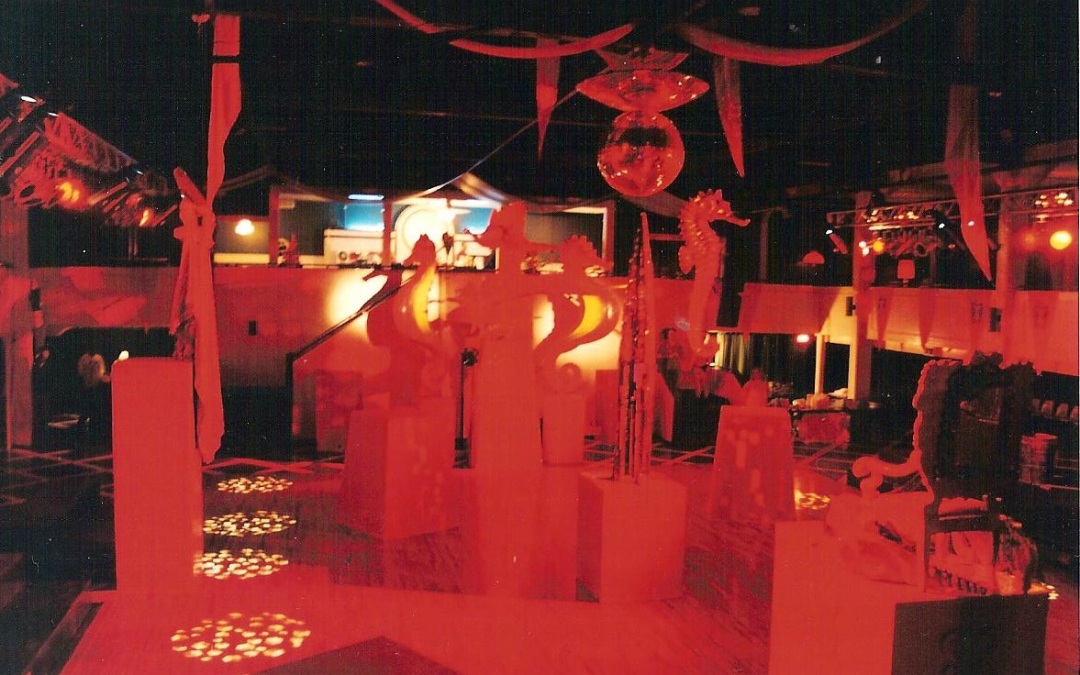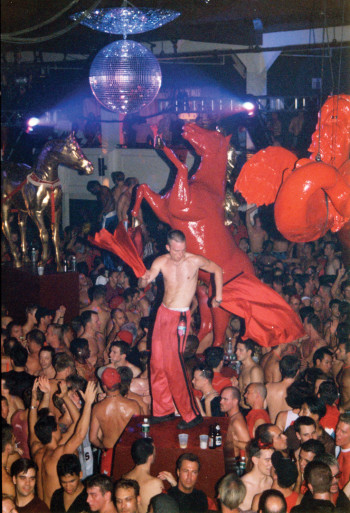Corbett Reynolds’ installation
……………………………………………………………………………………………………………………………………………………………………………………..
“Rudely Elegant”
By Thomas Queen
(Reprinted from December 29, 2014)
Life was much different for gay men and women in 1970s’ Columbus, Ohio. The few gay bars in town were mostly dives, and had no signage or visible street presence. Police raids were common, as was harassment from the general populace. It was at this time that a charming little man named Corbett Reynolds came along and helped put the city of Columbus on the map.
Born in Tacoma, Washington, Corbett received his formal art education at the Columbus College of Art and Design. Known for the contentious relationships he had with the faculty at the school, Corbett began to make a name for himself in the community which he had chosen to be his home. He soon founded a vintage clothing store near the Ohio State campus, long before the days when such attire was sold in expensive and trendy shops.
Corbett made a good living for 15 years designing wall coverings and textiles, and it was from the proceeds of this line of work that he was able to purchase his grand late 19th century mansion in the Victorian Village neighborhood of Columbus, years before it became the popular place to live that it is now. He spent the remaining years of his life transforming the home into his ultimate art installation, and the drumming sessions he hosted periodically in his backyard brought people together from all walks of life – artists, students, and even the priest from his Catholic church.
In 1975, Corbett purchased the Avondale Theater on West Broad Street in the Franklinton neighborhood of near west Columbus. He and his friends spent the next two years transforming this faded Art Deco gem into the nightclub, Rudely Elegant, which finally opened its doors in 1977. Inspired by the discos in New York and Chicago, the club’s interior installation was constantly changed to conform to the chosen theme of the night’s event, whether it was Tropicana, Uniform, or Red. The club became a local and ultimately a national destination, as attendees soon became caught up in the month’s theme and designed elaborate costumes for the event. As well, the club welcomed folks from all walks of life, and Corbett was especially happy when the avant-garde “artsy” types from the straight world came to join in the fun.
Equally as fantastic were the many noteworthy guest performers who Corbett brought to the club. Among them were Grace Jones; the legendary Sylvester; the edgy German performer Klaus Nomi; and Corbett’s good friend, the first international drag superstar, Divine. Long before raves were popular, Corbett staged parties that lasted into the wee hours of the morning, fueled by the music of nationally recognized DJ’s from New York and Chicago.When Rudely Elegant finally closed its doors in 1985, after a short time off, Corbett transformed his parties to become once-a-year events. Finally settling in at the historic Valley Dale Ballroom near Westerville. Corbett chose the parties to focus on his signature color, the one which “has always said everything about me…It is a color of passion, both in love and creativity”: Red.
Red Parties were part art installation, part performance art, much dancing, and magic and spectacle like no one had seen in Columbus before (or since). Each party centered on a chosen theme, among them Jungle Red (tropical), Red House Saloon (Western), and Big Red Top (circus). The installations were over the top, and 3000 revelers came to partake in these events from around the country, and from across the planet. In the last few years, Corbett chose to again bring celebrities from the underground to host his parties, and among them were Mink Stole, star of many John Waters films; Andy Warhol’s superstar, Holly Woodlawn, star of his film,”Trash”; and the final Red Party hostess, Tammy Faye Baker Messner.
If you look up “Circuit Party” on Wikipedia, you will see that Corbett Reynolds is acknowledged as the father of the gay circuit party. His parties were not just celebrations. They were a tribal experience, a mourning of lost friends, a life-changing inspiration to many “artsy” young gay boys who went on to big cities and made names for themselves in the creative world.
While Corbett poured much of his creative energy into the parties, he continued to create art from wood, paper, metal and stone. He was noted for taking simple everyday items and transforming them into objects of beauty. In fact, he was “repurposing” long before it became fashionable. His final series, a grouping of tall glass totems created from vintage lamp globes, titled “The Glass Menagerie”, was installed in the Windows space of NYU in January of 2002, to great acclaim. Just a few months later, he died of a heart attack on his way home from wintering in Florida, just shy of his 59th birthday.
For Corbett Reynolds, “Rudely Elegant” wasn’t just the name of his legendary nightclub in Columbus, Ohio. It was how he lived his life: in your face, but with panache.
……………………………………………………………………………………………………………………………………………………………………………………..
……………………………………………………………………………………………………………………………………………………………………………………..
About the Author:



Recent Comments